Abstract
A total of 221 strains of staphylococci and 98 strains of micrococci isolated from the skins of Eastern gray squirrels, Southern flying squirrels, raccoons, opossums, squirrel monkeys, swine, sheep, horses, cattle, and dogs were characterized in a preliminary attempt to resolve their natural relationships and distribution in nature. Staphylococci demonstrating the widest host range included Staphylococcus xylosus and unnamed Staphylococcus sp. 3. Unnamed Staphylococcus sp. 2 was isolated only from sheep, Staphylococcus sp. 4 only from opossums, Staphylococcus sp. 5 only from squirrel monkeys, and Staphylococcus sp. 6 only from swine. The predominant species isolated from human skin, including S. epidermidis, S. hominis, S. haemolyticus, and S. capitis, were either not isolated or only rarely isolated from animal skin. Micrococcus varians was the predominant Micrococcus species isolated from animal skin. M. luteus was only occasionally isolated. M. lylae, M. sedentarius, M. roseus, M. kristinae, and M. nishinomiyaensis, species occasionally isolated from human skin, were not isolated from animal skin.
Full text
PDF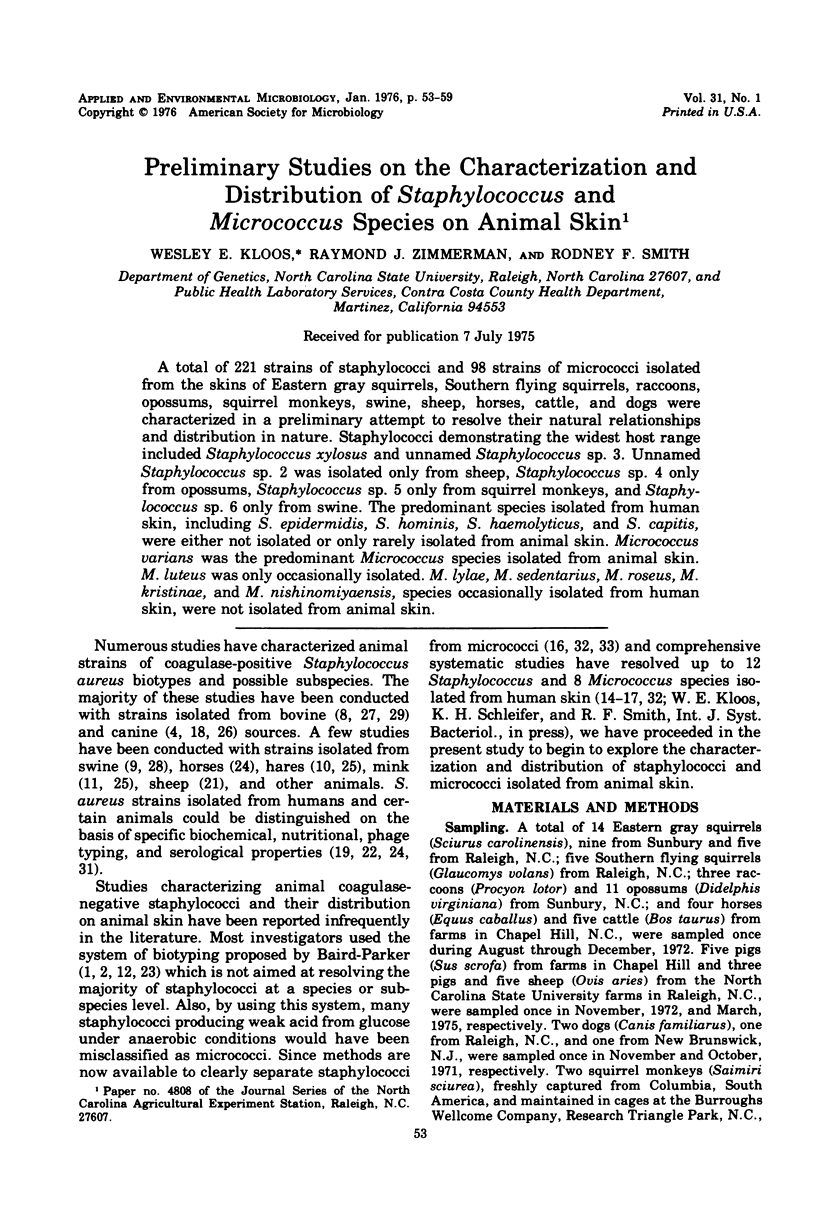
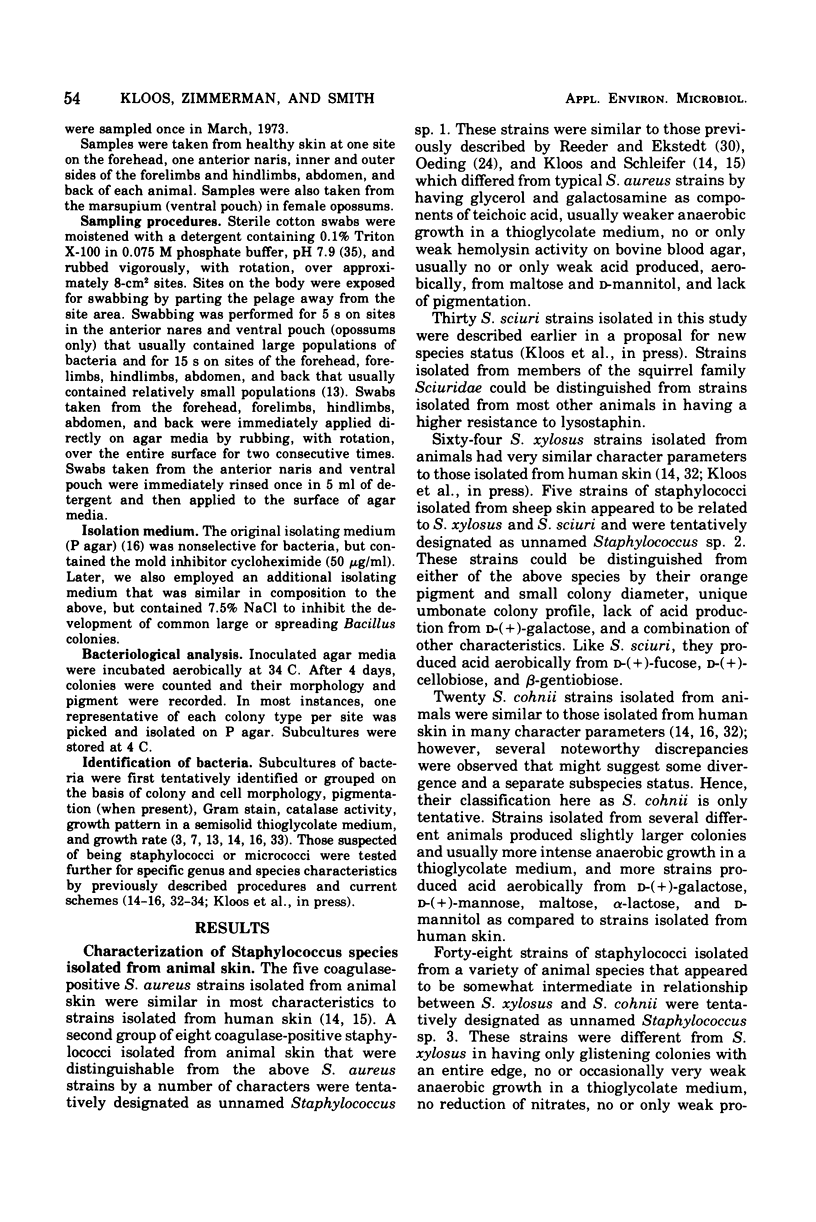
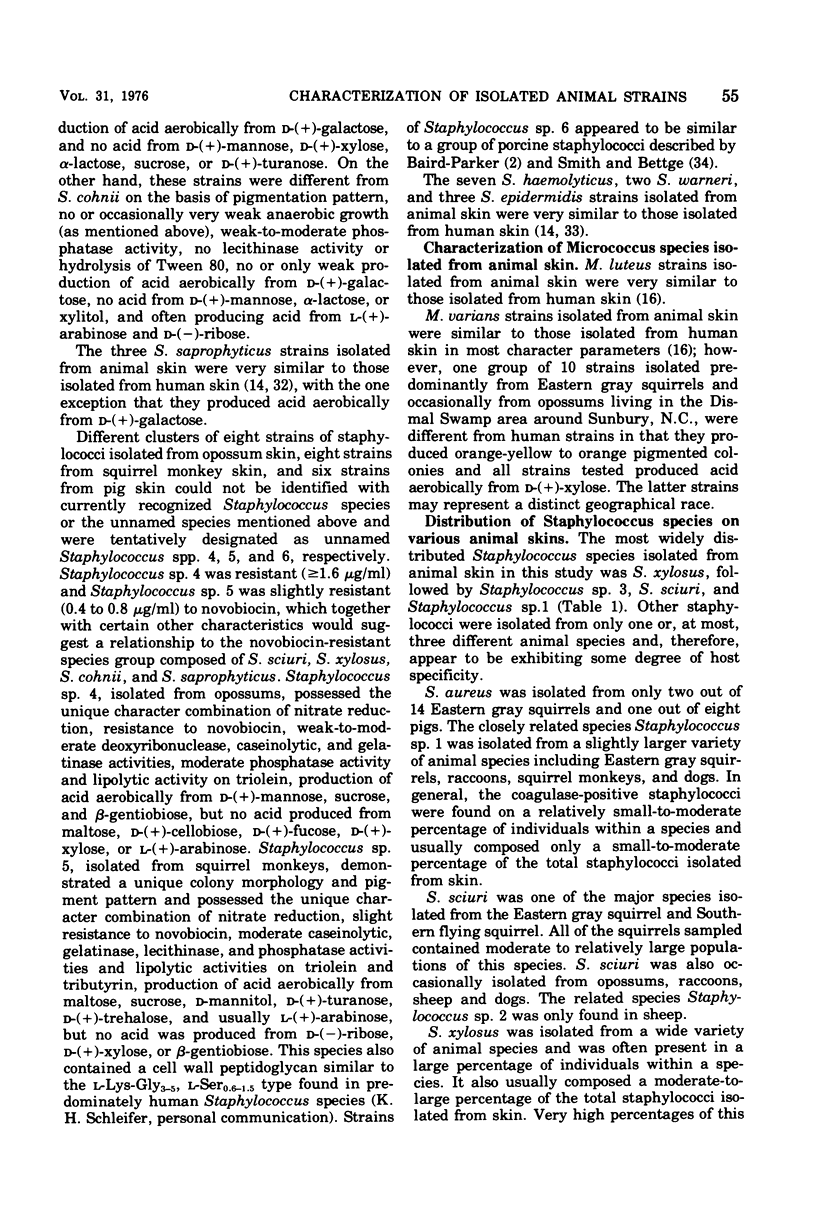
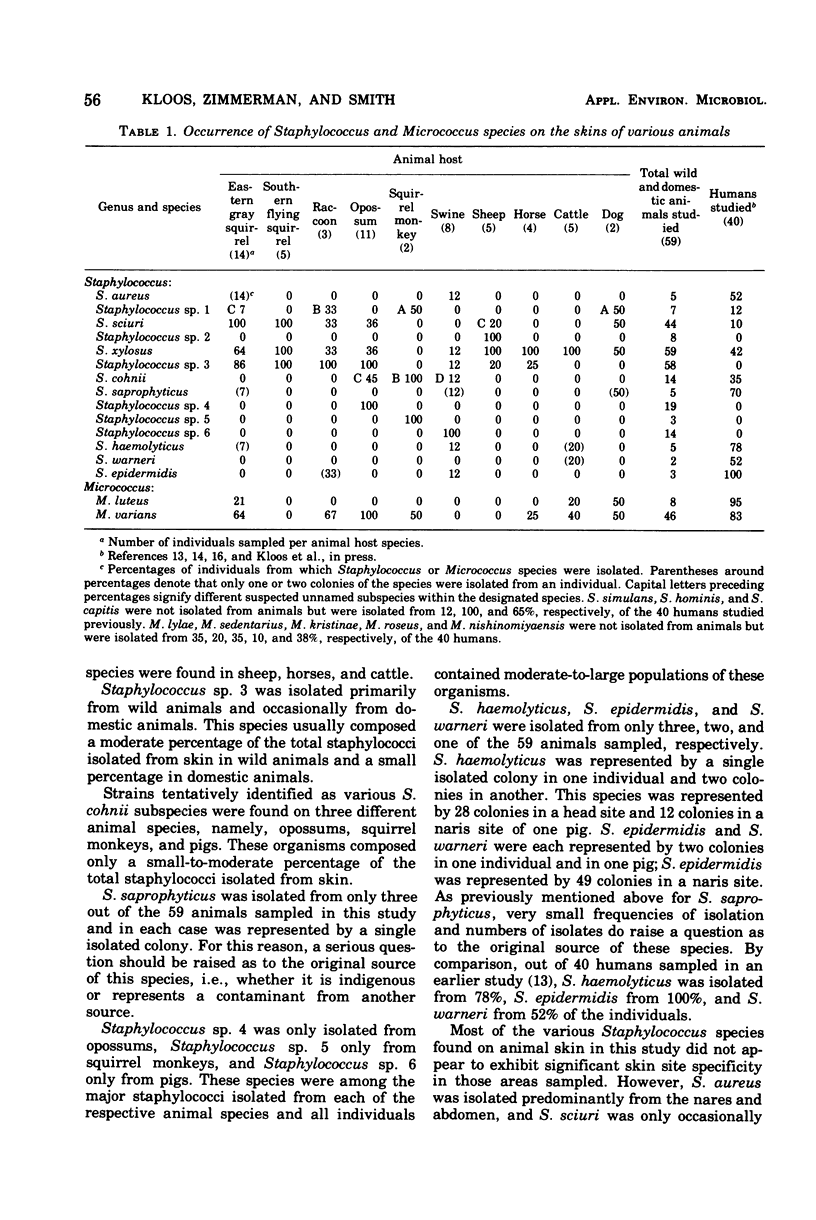
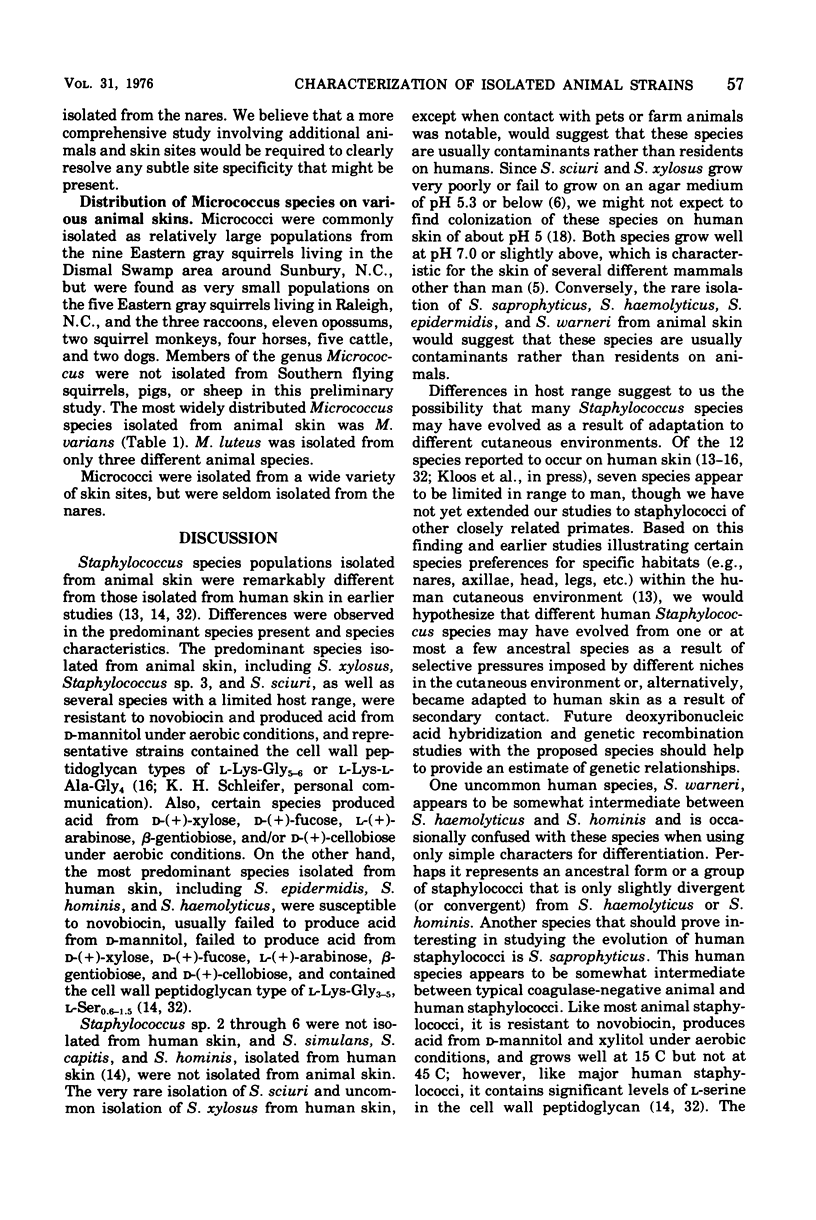
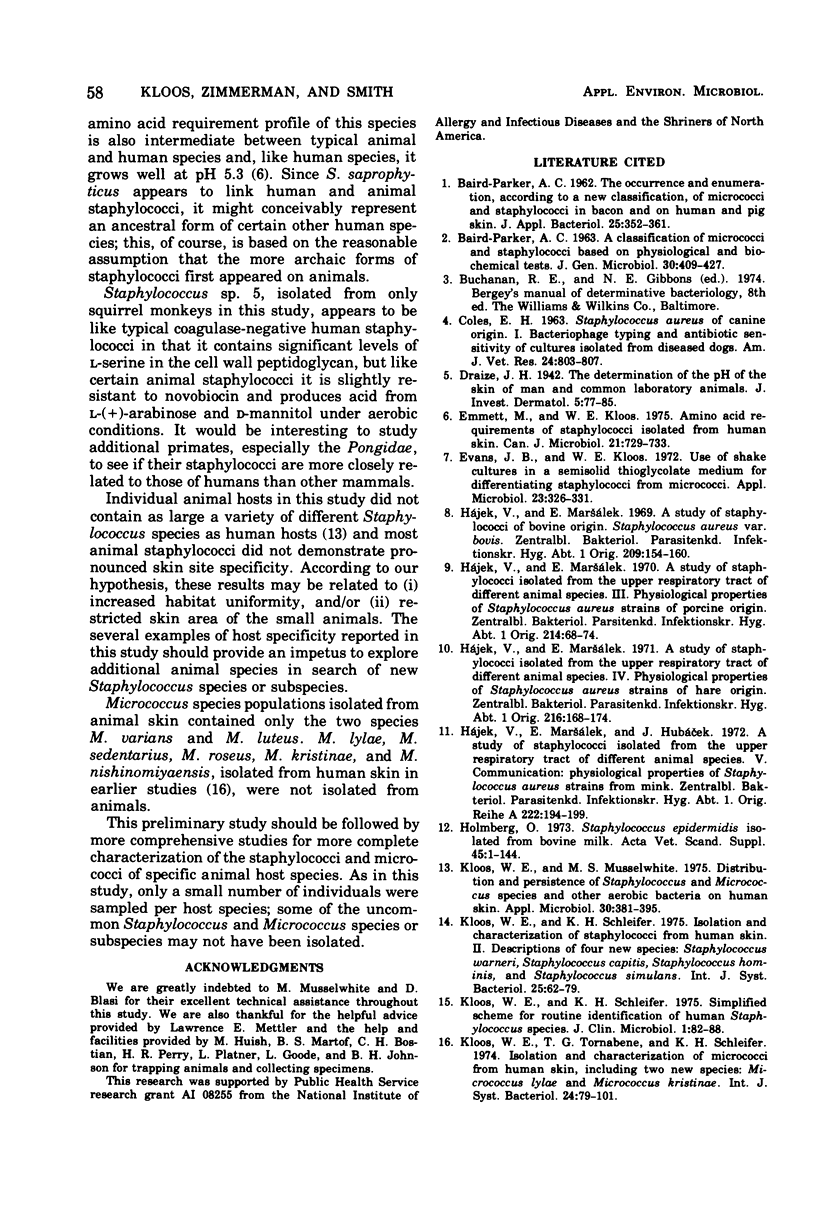
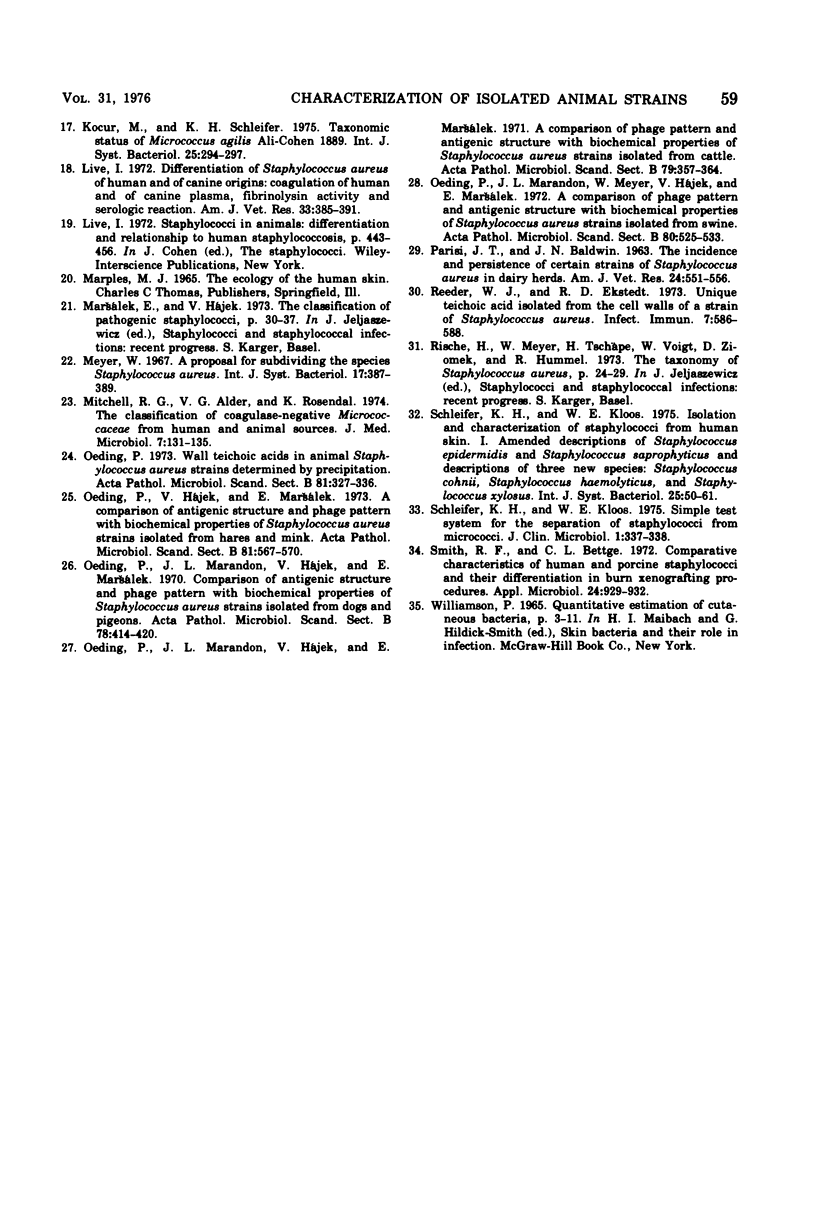
Selected References
These references are in PubMed. This may not be the complete list of references from this article.
- BAIRD-PARKER A. C. A classification of micrococci and staphylococci based on physiological and biochemical tests. J Gen Microbiol. 1963 Mar;30:409–427. doi: 10.1099/00221287-30-3-409. [DOI] [PubMed] [Google Scholar]
- COLES E. H. Staphylococcus aureus of canine origin. I. Bacteriophage typing and antibiotic sensitivity of cultures isolated from diseased dogs. Am J Vet Res. 1963 Jul;24:803–807. [PubMed] [Google Scholar]
- Emmett M., Kloos W. E. Amino acid requirements of staphylococci isolated from human skin. Can J Microbiol. 1975 May;21(5):729–733. doi: 10.1139/m75-107. [DOI] [PubMed] [Google Scholar]
- Evans J. B., Kloos W. E. Use of shake cultures in a semisolid thioglycolate medium for differentiating staphylococci from micrococci. Appl Microbiol. 1972 Feb;23(2):326–331. doi: 10.1128/am.23.2.326-331.1972. [DOI] [PMC free article] [PubMed] [Google Scholar]
- Holmberg O. Staphylococcus epidermidis isolated from bovine milk. Biochemical properties, phage sensitivity and pathogenicity for the udder. Acta Vet Scand Suppl. 1973:1–144. [PubMed] [Google Scholar]
- Hájek V., Marsálek E. A study of staphylococci isolated from the upper respiratory tract of different animal species. IV. Physiological properties of Staphylococcus aureus strains of hare origin. Zentralbl Bakteriol Orig. 1971;216(2):168–174. [PubMed] [Google Scholar]
- Hájek V., Marsálek E. A study of staphylococci isolated from upper respiratory tract of different animal species. 3. Physiological properties of Staphylococcus aureus strains of porcine origin. Zentralbl Bakteriol Orig. 1970;214(1):68–74. [PubMed] [Google Scholar]
- Hájek V., Marsálek E. A study of staphylococci of bovine origin Staphylococcus aureus var. bovis. Zentralbl Bakteriol Orig. 1969 Jan;209(2):154–160. [PubMed] [Google Scholar]
- Hájek V., Marsálek E., Hubácek J. A study of staphylococci isolated from the upper respiratory tract of different animal species. V. Physiological properties of Staphylococcus aureus strains from mink. Zentralbl Bakteriol Orig A. 1972 Nov;222(2):194–199. [PubMed] [Google Scholar]
- Kloos W. E., Musselwhite M. S. Distribution and persistence of Staphylococcus and Micrococcus species and other aerobic bacteria on human skin. Appl Microbiol. 1975 Sep;30(3):381–385. doi: 10.1128/am.30.3.381-395.1975. [DOI] [PMC free article] [PubMed] [Google Scholar]
- Kloos W. E., Schleifer K. H. Simplified scheme for routine identification of human Staphylococcus species. J Clin Microbiol. 1975 Jan;1(1):82–88. doi: 10.1128/jcm.1.1.82-88.1975. [DOI] [PMC free article] [PubMed] [Google Scholar]
- Live I. Differentiation of Staphylococcus aureus of human and of canine origins: coagulation of human and of canine plasma, fibrinolysin activity, and serologic reaction. Am J Vet Res. 1972 Feb;33(2):385–391. [PubMed] [Google Scholar]
- Marsálek E., Hájek V. The classification of pathogenic staphylococci. Contrib Microbiol Immunol. 1973;1:30–37. [PubMed] [Google Scholar]
- Mitchell R. G., Alder V. G., Rosendal K. The classification of coagulase-negative Micrococcaceae from human and animal sources. J Med Microbiol. 1974 Feb;7(1):131–135. doi: 10.1099/00222615-7-1-131. [DOI] [PubMed] [Google Scholar]
- Oeding P., Hájek V., Marsálek E. A comparison of antigenic structure and phage pattern with biochemical properties of Staphylococcus aureus strains isolated from hares and mink. Acta Pathol Microbiol Scand B Microbiol Immunol. 1973 Oct;81(5):567–570. doi: 10.1111/j.1699-0463.1973.tb02244.x. [DOI] [PubMed] [Google Scholar]
- Oeding P., Marandon J. L., Hájek V., Marsálek E. A comparison of phage pattern and antigenic structure with biochemical properties of Staphylococcus aureus strains isolated from cattle. Acta Pathol Microbiol Scand B Microbiol Immunol. 1971;79(3):357–364. doi: 10.1111/j.1699-0463.1971.tb00073.x. [DOI] [PubMed] [Google Scholar]
- Oeding P., Marandon J. L., Meyer W., Hájek V., Marsálek E. A comparison of phage pattern and antigenic structure with biochemical properties of Staphylococcus aureus strains isolated from swine. Acta Pathol Microbiol Scand B Microbiol Immunol. 1972;80(4):525–533. doi: 10.1111/j.1699-0463.1972.tb00176.x. [DOI] [PubMed] [Google Scholar]
- Oeding P. Wall teichoic acids in animal Staphylococcus aureus strains determined by precipitation. Acta Pathol Microbiol Scand B Microbiol Immunol. 1973 Jun;81(3):327–336. doi: 10.1111/j.1699-0463.1973.tb02211.x. [DOI] [PubMed] [Google Scholar]
- PARISI J. T., BALDWIN J. N. The incidence and persistence of certain strains of Staphylococcus aureus in dairy herds. Am J Vet Res. 1963 May;24:551–556. [PubMed] [Google Scholar]
- Reeder W. J., Ekstedt R. D. Unique teichoic acid isolated from the cell walls of a strain of Staphylococcus aureus. Infect Immun. 1973 Apr;7(4):586–588. doi: 10.1128/iai.7.4.586-588.1973. [DOI] [PMC free article] [PubMed] [Google Scholar]
- Rische H., Meyer W., Tschäpe, Voigt W., Ziomek D., Hummel R. The taxonomy of Staphylococcus aureus. Contrib Microbiol Immunol. 1973;1:24–29. [PubMed] [Google Scholar]
- Schleifer K. H., Kloos W. E. A simple test system for the separation of staphylococci from micrococci. J Clin Microbiol. 1975 Mar;1(3):337–338. doi: 10.1128/jcm.1.3.337-338.1975. [DOI] [PMC free article] [PubMed] [Google Scholar]
- Smith R. F., Bettge C. L. Comparative characteristics of human and porcine staphylococci and their differentiation in burn xenografting procedures. Appl Microbiol. 1972 Dec;24(6):929–932. doi: 10.1128/am.24.6.929-932.1972. [DOI] [PMC free article] [PubMed] [Google Scholar]


